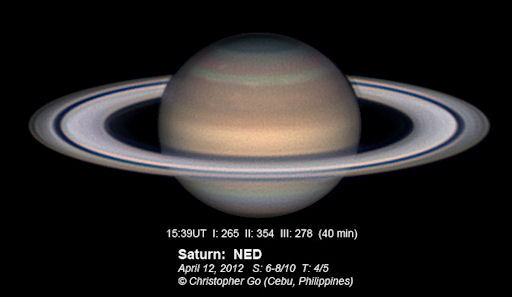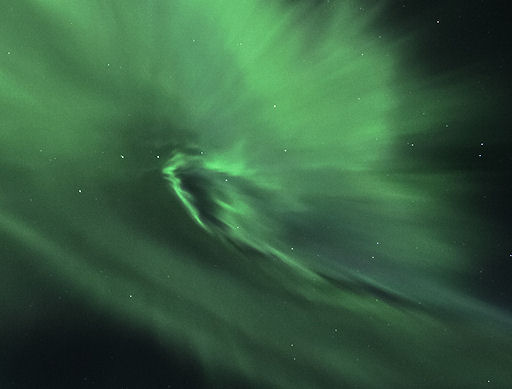SATURN'S RINGS AT THEIR BEST: On Sunday, April 15th, Saturn is at opposition--directly opposite the sun in the skies of Earth. The ringed planet rises at sunset and soars high in the sky at midnight, up all night long. This is the time when Saturn's rings are at their best. From the point of view of Earth, shadows in the ring plane almost completely disappear (just as your own shadow tries to hide beneath your feet at noon) and sunlight is directly backscattered by icy ring particles toward our planet.
Amateur astronomer Christopher Go photographed the brightening rings on April 12th:
"Saturn is close to opposition and the rings are brightening. This is the Seeliger Effect," says Go. "Also a Northern Electrostatic Disturbance, which was detected by Cassini a few days ago, can be seen as a white patch north of the green belt."
Saturn is easy to find. Look south at midnight. The ringed planet forms a "double star" with Spica. [sky map]
more images: from Efrain Morales Rivera of Aguadilla, Puerto Rico
WEEKEND AURORAS: For the third day in a row, a high-speed solar wind stream is buffeting Earth's magnetic field. On Saturday, April 14th, an intense burst of auroras appeared over Bodø, Norway:
"The lights went from nothing to extreme in a very short time," says photographer Sindre Nedrevåg. "The background was pretty, too: There was Venus and a lot of stars, together with the colours of the sunset. The auroras became so intense that even 3 seconds of exposure wasn't fast enough with my Nikon D300s at ISO 640."
NOAA forecasters estimate a 10% to 15% chance of more geomagnetic activity during the next 24 hours as the solar wind continues to blow. Aurora alerts: text, phone.
more images: from Sylvain Serre of Ivujivik, Nunavik, Quebec, Canada; from Einar Halvorsrud of Alta, Norway; from Yuri Gnatyuk of Arkhangelsk, Russia; from Gregory Lacy of the Yukon River north of Fairbanks, Alaska; from Jónína Óskarsdóttir of Faskrudsfjordur, Iceland; from Eric Fokke of Norway, Lofoten; from Brian Tomlinson of Reykjavik Iceland; from B.Art Braafhart of Salla, Finnish Lapland;

![]()
Solar wind
speed: 446.5 km/sec
density: 0.1 protons/cm3
explanation | more data
Updated: Today at 1626 UT
![]()
X-ray Solar Flares
6-hr max: B4 1001 UT Apr15
24-hr: C2 0142 UT Apr15
explanation | more data
Updated: Today at: 1600 UT
![]()
![]()
![]()
Daily Sun: 15 Apr 12
![]()
![]()
Sunspot AR1458 is crackling with C-class solar flares. This, plus the emergence of AR1459, could signal an uptick in solar activity. Credit: SDO/HMI
![]() Sunspot number: 65
Sunspot number: 65
What is the sunspot number?
Updated 14 Apr 2012
Spotless Days
Current Stretch: 0 days
2012 total: 0 days (0%)
2011 total: 2 days (<1%)
2010 total: 51 days (14%)
2009 total: 260 days (71%)
Since 2004: 821 days
Typical Solar Min: 486 days
Updated 14 Apr 2012
The Radio Sun
10.7 cm flux: 98 sfu
explanation | more data
Updated 14 Apr 2012
![]()
![]()
![]()
Current Auroral Oval:
![]()
Switch to: Europe, USA, New Zealand, Antarctica
Credit: NOAA/POES
![]()
![]()
![]()
Planetary K-index
Now: Kp= 1 quiet
24-hr max: Kp= 2 quiet
explanation | more data
![]()
Interplanetary Mag. Field
Btotal: 3.4 nT
Bz: 1.9 nT south
explanation | more data
Updated: Today at 1627 UT
![]()
![]()
![]()
Coronal Holes: 15 Apr 12
![]()
![]()
There are no large coronal holes on tthe Earthside of the sun. Credit: SDO/AIA.






